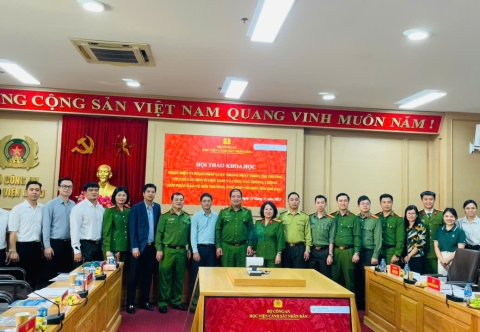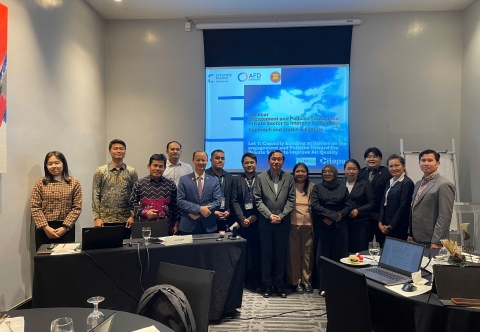As a matter of fact, Vietnam is an export-driven country, with the U.S. being a particularly important market. In 2024, Vietnam's export turnover to the U.S. reached USD 119.6 billion, representing a significant proportion of the country's total export turnover. Key items like textiles, footwear, wood products, and electronic components contributed largely to this figure. This highlights that the tariff increase on Vietnamese goods to the U.S. will pose significant challenges for Vietnamese enterprises.
.png)
The impact of this new tariff policy extends beyond cost and competitiveness issues and will have a widespread effect on the green transition of businesses. As Vietnam intensifies its commitment to reducing emissions and sustainable development, the heavy tax burden could hinder the capacity to invest in green technologies. Key export industries like textiles, seafood, wood, and electronic components, which are in the process of greening their production, could face major challenges.
1. Financial Pressure Hampers Green Investments
The high tariff means that export businesses will face additional costs, which will reduce profits and reinvestment funds for sustainable projects. Many companies in the process of transitioning to energy-efficient production models, using recycled materials, or implementing emissions-reducing technologies may have to delay or cut back on these plans to maintain business operations.
For instance, the textile industry, one of the main export sectors to the U.S., has made strong commitments to sustainable development. However, when export costs rise due to higher tariffs, businesses in this sector may prioritize maintaining competitiveness over investing in environmental initiatives.
2. Risk of Losing Competitiveness in the Global Supply Chain
Vietnam is a key player in the global supply chain, especially in textiles, electronics, footwear, and seafood. With labor cost advantages and a strategic location in Southeast Asia, Vietnam has become a major production and manufacturing hub for global brands. However, the risk of losing this advantage is growing due to high U.S. tariffs, which could increase export costs and reduce the competitiveness of Vietnamese businesses in global supply chains. Moreover, failing to adapt to global trends like green transformation and new technologies—such as the EU’s Carbon Border Adjustment Mechanism (CBAM), which requires transparency on carbon emissions—could make Vietnamese products face significant difficulties in global markets.
Furthermore, heavy reliance on key markets makes Vietnam vulnerable to global economic and political fluctuations. Without timely adjustments, businesses may lose orders and be forced to cut costs by using cheaper materials or delaying environmental protection initiatives.
Opportunities for Restructuring and Market Expansion
Despite the significant challenges posed by the new U.S. tariff policy, this could also be an opportunity for Vietnamese enterprises to make a strong transformation. Tariff barriers not only create pressure but also motivate businesses to enhance their competitiveness and adapt to the new environment.
Reducing reliance on the U.S. market could open new paths for Vietnam, allowing businesses to diversify export markets. This is a perfect time to explore opportunities in potential markets such as the EU, Japan, South Korea, and ASEAN—regions with high demand for environmentally friendly products. This shift would not only help to reduce risks but also upgrade brand value and long-term sustainable growth.
Additionally, the new tariff policy serves as a wake-up call for businesses to accelerate the greening of production, not only to meet international standards but also to enhance brand value and long-term competitiveness. Companies can leverage financial incentives from the government and international organizations to invest in green technologies, building a sustainable development foundation to cope with global trade fluctuations.
The U.S. imposing a 46% tariff on imported goods from Vietnam will certainly negatively affect exports and the green transition of businesses. However, it also provides an opportunity for businesses to restructure, explore new markets, and ramp up investments in clean technologies to enhance long-term competitiveness. To adapt, businesses need to be flexible in adjusting their business strategies, make use of financial and technological support, and continue pursuing sustainable development models to ensure their position in the global supply chain.
 Scientific conference on Identifying Legal Violations in the Development of the Carbon Credit Market in Vietnam
Scientific conference on Identifying Legal Violations in the Development of the Carbon Credit Market in Vietnam
_cr_480x332.jpg) 50 years Vietnam - Germany Alumni - Workshop: Journey from Pioneering to Sustainable Development in the Digital Age
50 years Vietnam - Germany Alumni - Workshop: Journey from Pioneering to Sustainable Development in the Digital Age
 Fostering Air Quality in ASEAN: Highlights from the “Engagement and Policies Toward the Private Sector to Improve Air Quality” Seminar
Fostering Air Quality in ASEAN: Highlights from the “Engagement and Policies Toward the Private Sector to Improve Air Quality” Seminar